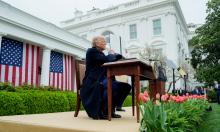American art dealer appearances in Rome
An American art dealer appeared for the first time Friday at a trial in which he is accused along with a former curator of the J. Paul Getty Museum of receiving and conspiring to deal in illegally acquired antiquities. Prosecutors allege that Robert Hecht, 86, and former Getty Museum curator Marion True knowingly trafficked stolen art, in a case seen as a warning from Italy to the art world. Hecht and True deny any wrongdoing.
Hecht listened intently, one hand cupped to his ear, as prosecution witness Maurizio Pellegrini, an archaeological expert, presented documents projected onto a screen in the Rome courtroom Friday. One of the documents was an internal Getty museum memo that mentions a 5th century B.C. Etruscan statuette and says someone identified as "REH" had indicated that the statuette was found at the Cerveteri site near Rome.
Prosecutors claim that the object was one of those dug up in violation of an Italian law that stipulates that any antiquity found on Italian soil belongs to the Italian state. "We believe that REH is one of the names by which Hecht was known," Pellegrini said, referring to Hecht's full name, Robert Emanuel Hecht. "This indication is a further proof that there were contacts with the diggers."
"The fact that it comes from the necropolis (of Cerveteri) is known only to the diggers or to those who are in contact with the diggers." Hecht refused to answer questions by journalists on specific issues relating to the trial saying only, "When I am questioned (by the court) I will answer." He seemed confident of the outcome of the trial and mocked the prosecution's arguments saying "forgive them for they don't know what they are doing." True appeared at a hearing in November, but made no comments to reporters at the time, reports the AP. N.U.
Subscribe to Pravda.Ru Telegram channel, Facebook, RSS!





